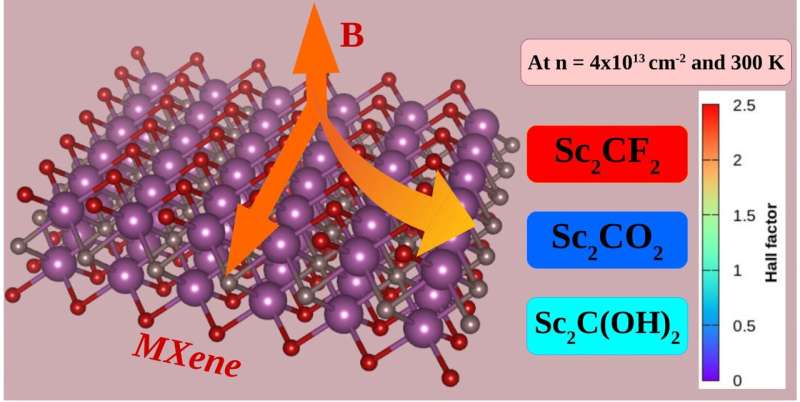This article has been reviewed according to Science X's editorial process and policies. Editors have highlighted the following attributes while ensuring the content's credibility:
fact-checked
peer-reviewed publication
proofread
Method to measure molecular distribution of MXene enables quality control in production process

Developed in 2011, MXene is a two-dimensional nanomaterial with alternating metal and carbon layers, which has high electrical conductivity and can be combined with various metal compounds, making it a material that can be utilized in various industries such as semiconductors, electronic devices, and sensors.
To properly utilize MXene, it is important to know the type and amount of molecules covered on the surface, and if the molecules covered on the surface are fluorine, the electrical conductivity of decreases and the efficiency of electromagnetic wave shielding decreases. However, since it is only 1nm thick, it takes several days to analyze the molecules on the surface even with a high-performance electron microscope, so mass production has been impossible until now.
The research team led by Seung-Cheol Lee, director of the Indo-Korea Science and Technology Center(IKST) at the Korea Institute of Science and Technology(KIST), has developed a method to predict the distribution of molecules on the surface using the magnetoresistance property of MXene. The paper is published in the journal Nanoscale.
By utilizing this method, it is possible to measure the molecular distribution of MXene with a simple measurement, enabling quality control in the production process, which is expected to open the way to mass production that was not previously possible.
The research team developed a two-dimensional material property prediction program based on the idea that electrical conductivity or magnetic properties change depending on the molecules attached to the surface. They calculated the magnetic transport properties of MXene and succeeded in analyzing the type and amount of molecules adsorbed on the surface of MXene at atmospheric pressure and room temperature without any additional devices.
By analyzing the surface of the MXene with the developed property prediction program, it was predicted that the Hall scattering factor, which affects magnetic transport, changes dramatically depending on the type of surface molecules.
The Hall Scattering Factor is a physical constant that describes the charge-carrying properties of semiconductor materials, and the team found that even when the same MXene was prepared, the Hall Scattering Factor had a value of 2.49, the highest for fluorine, 0.5 for oxygen, and 1 for hydroxide, allowing them to analyze the distribution of the molecules.
The Hall scattering coefficient has different applications based on the value of 1. If the value is lower than 1, it can be applied to high-performance transistors, high-frequency generators, high-efficiency sensors, and photodetectors, and if the value is higher than 1, it can be applied to thermoelectric materials and magnetic sensors. Considering that the size of the MXene is a few nanometers or less, the size of the applicable device and the amount of power required can be dramatically reduced.
"Unlike previous studies that focused on the production and properties of pure MXene, this study is significant in that it provides a new method for surface molecular analysis to easily classify manufactured MXene," said Seung-Cheol Lee, director of IKIST. "By combining this result with experimental studies, we expect to be able to control the production process of MXene, which will be used to mass produce MXene with uniform quality."
IKST was established in 2010 and conducts research in the areas of theory, source code, and software for computational science. In particular, source code is a programming language that implements algorithms that can be modeled and simulated, and is considered an original research in the field of computational science, and the center conducts collaborative research with Indian universities and research institutes such as IIT Bombay to develop source code.
More information: Namitha Anna Koshi et al, Can magnetotransport properties provide insight into the functional groups in semiconducting MXenes?, Nanoscale (2023). DOI: 10.1039/D2NR06409J
Journal information: Nanoscale
Provided by National Research Council of Science & Technology





















